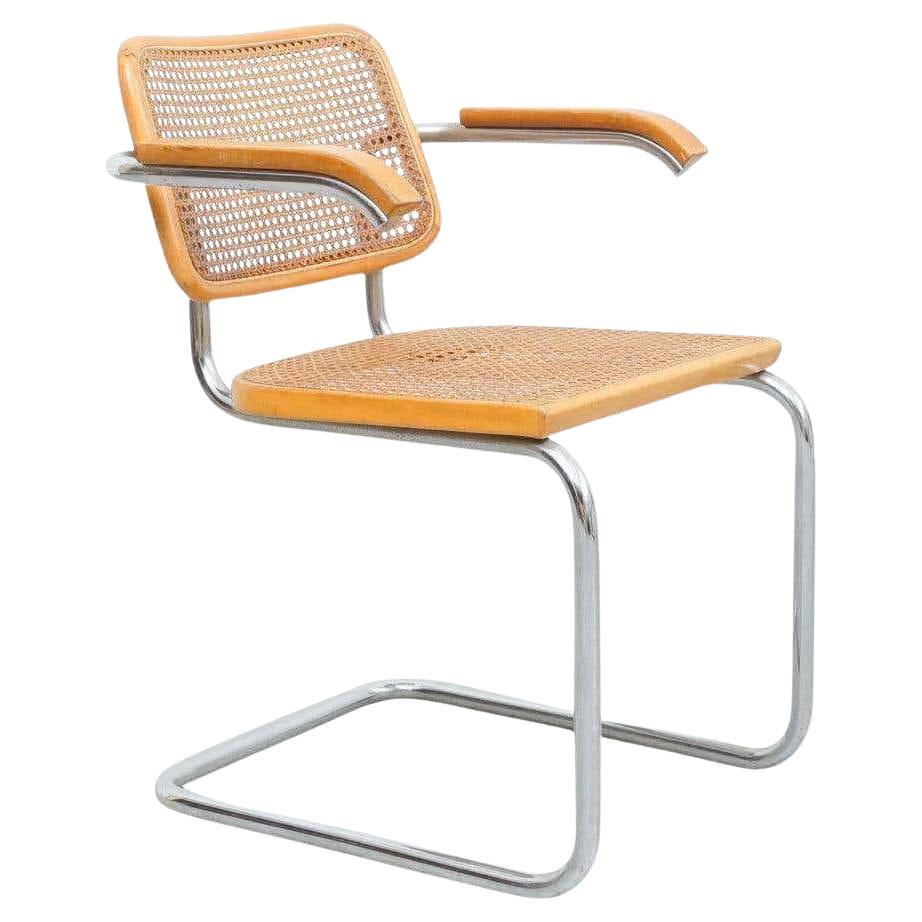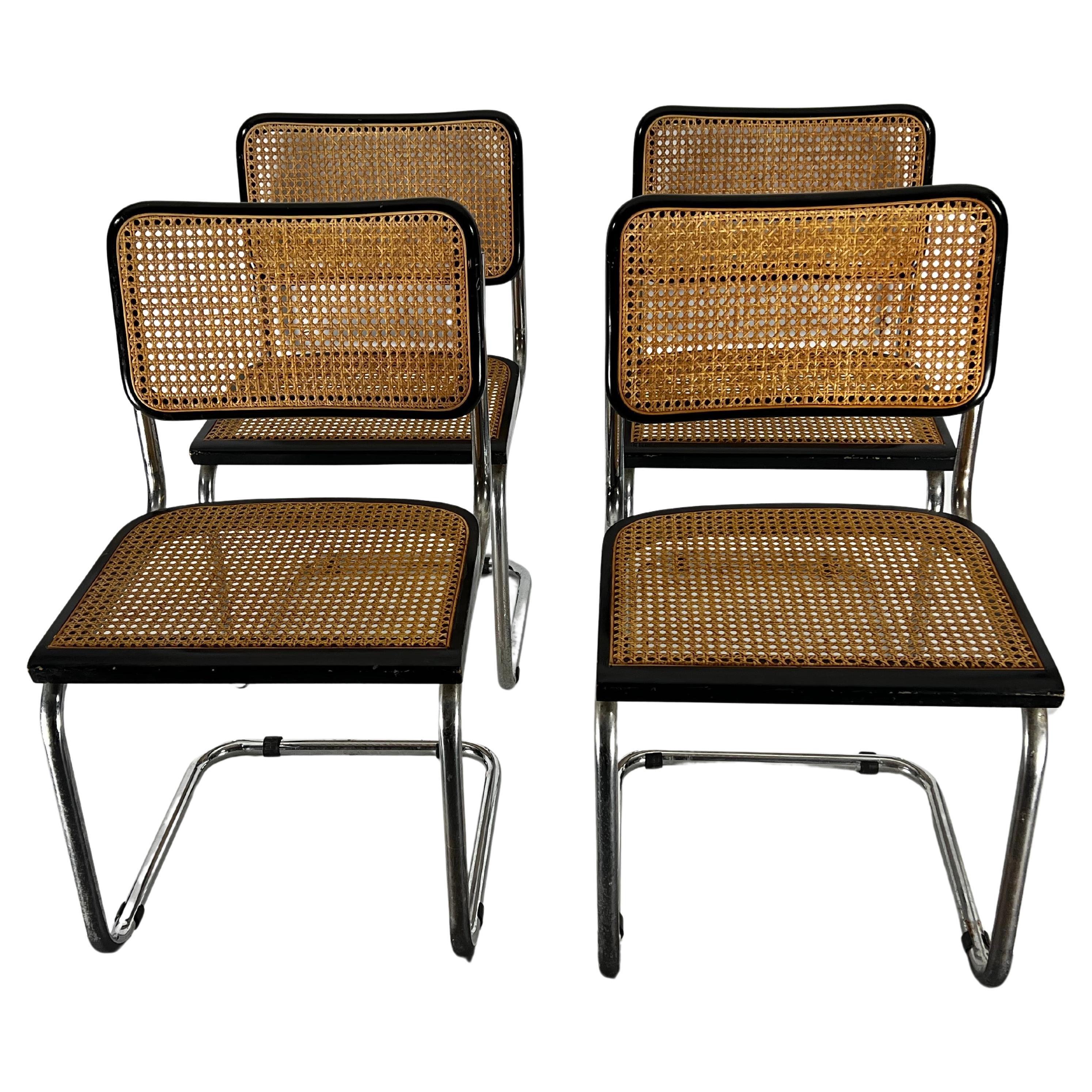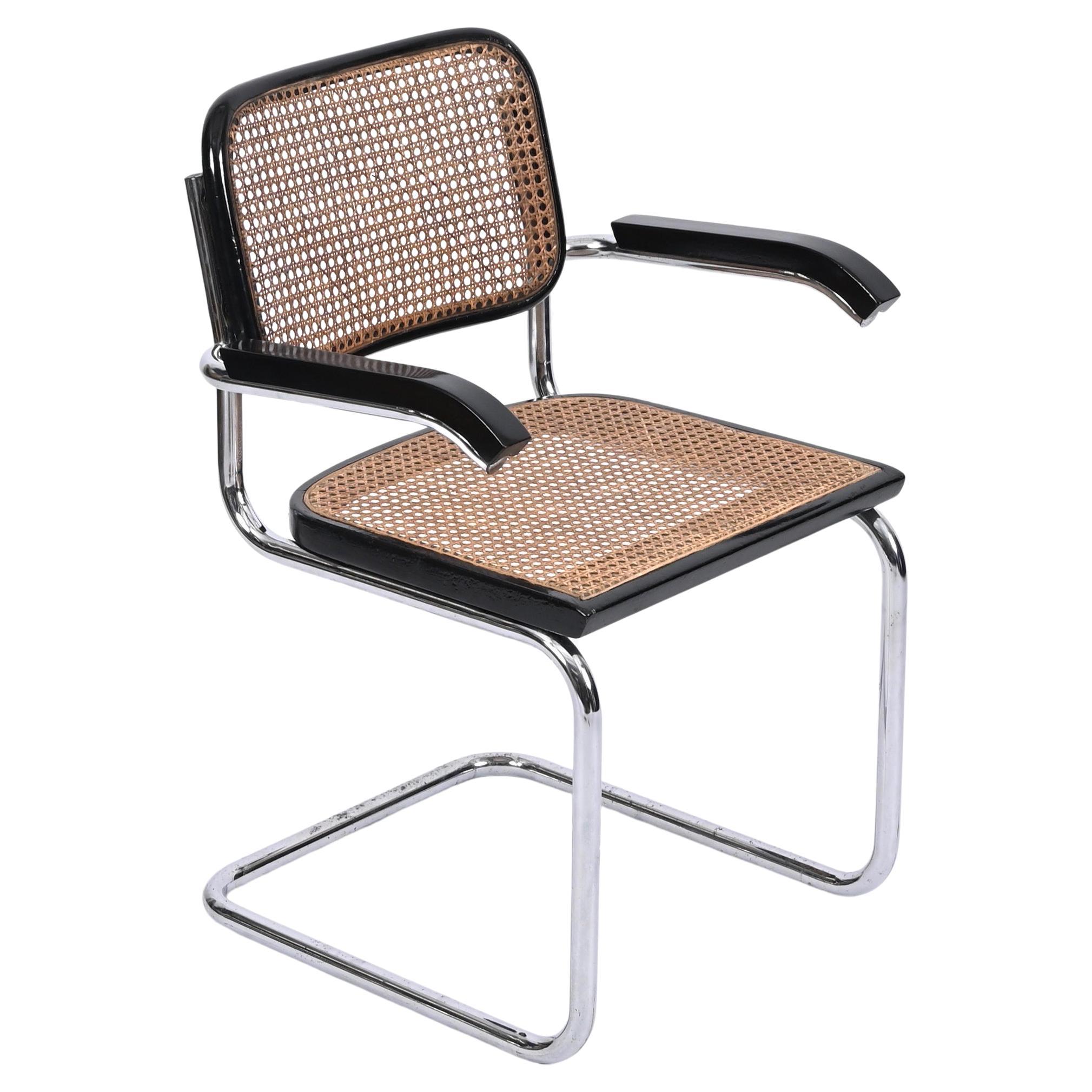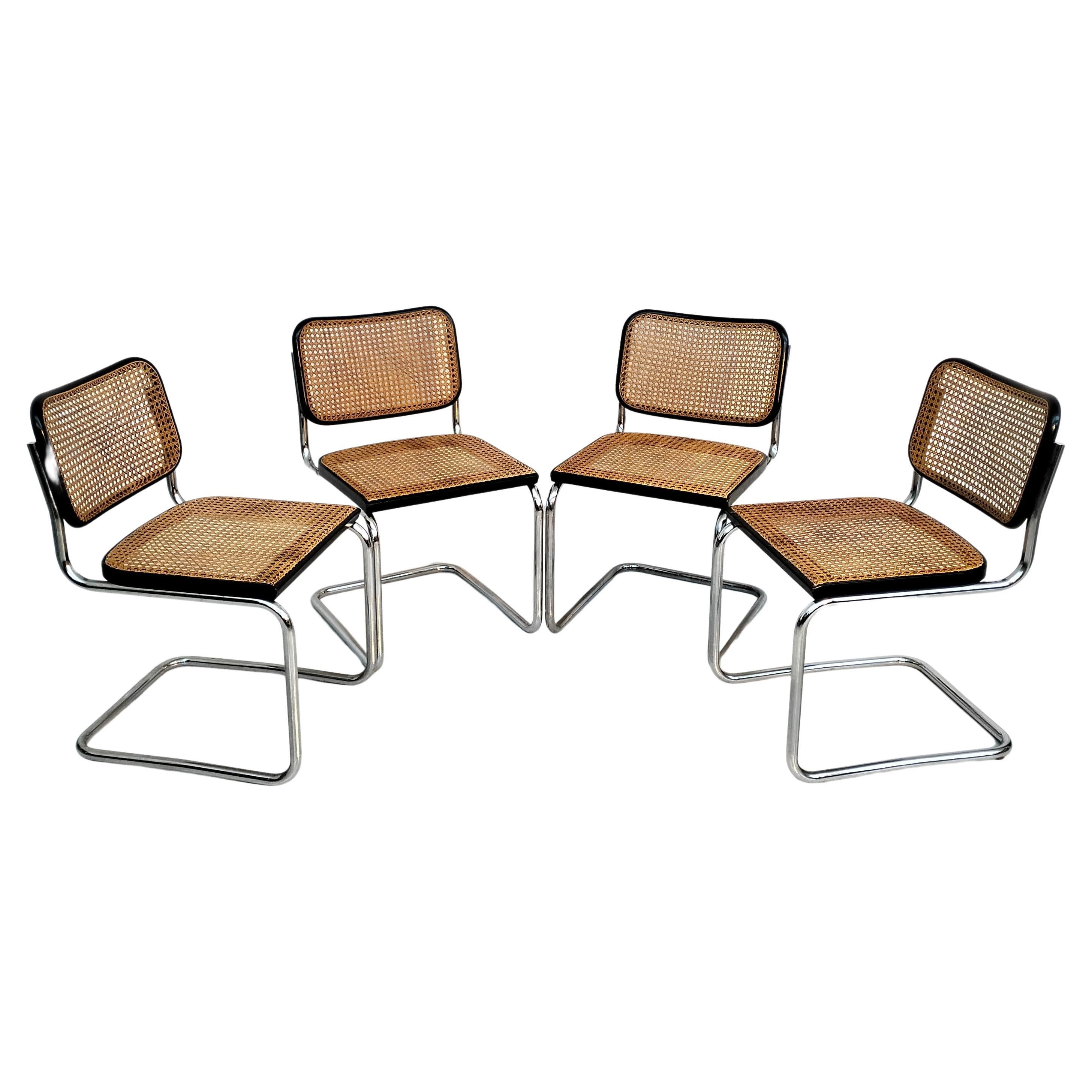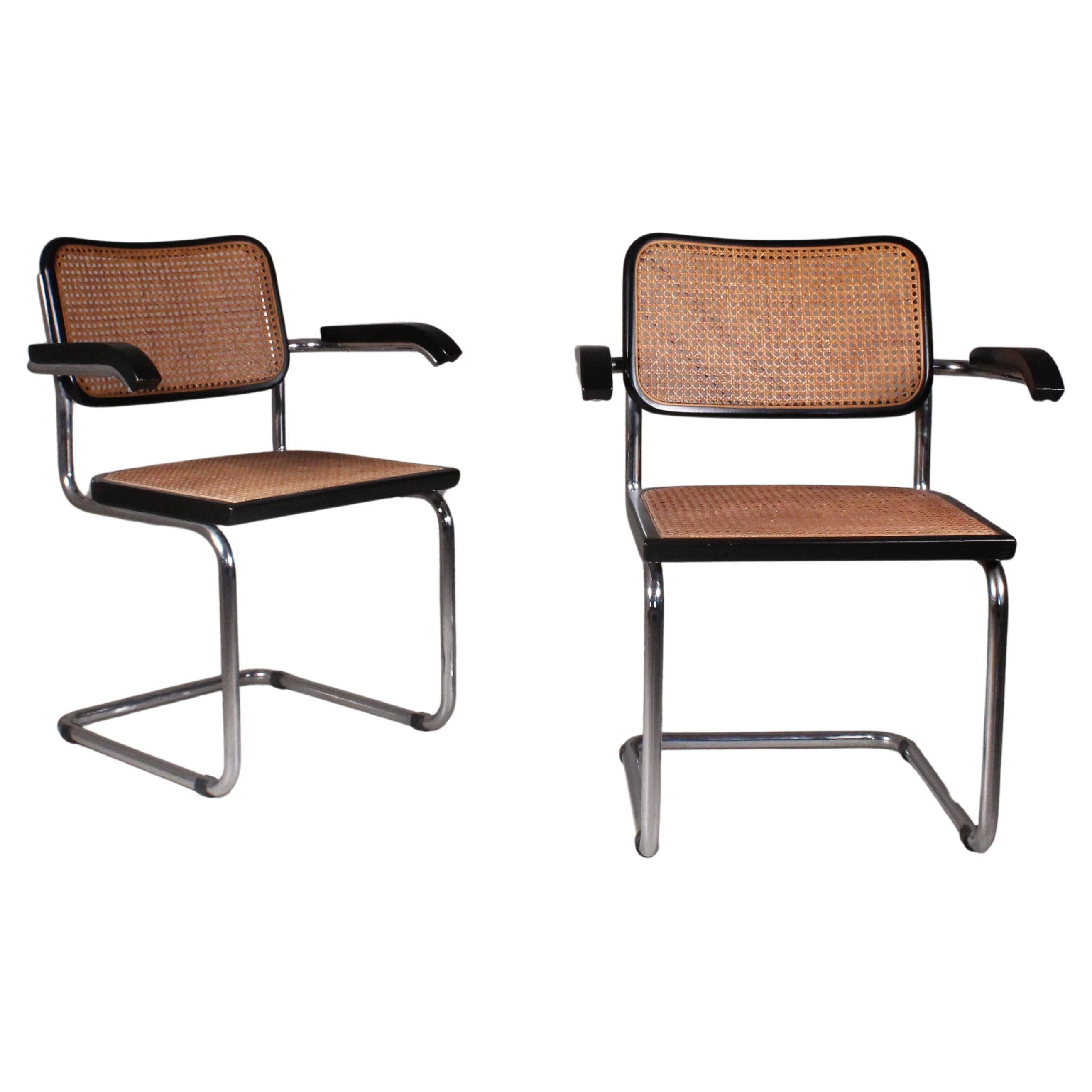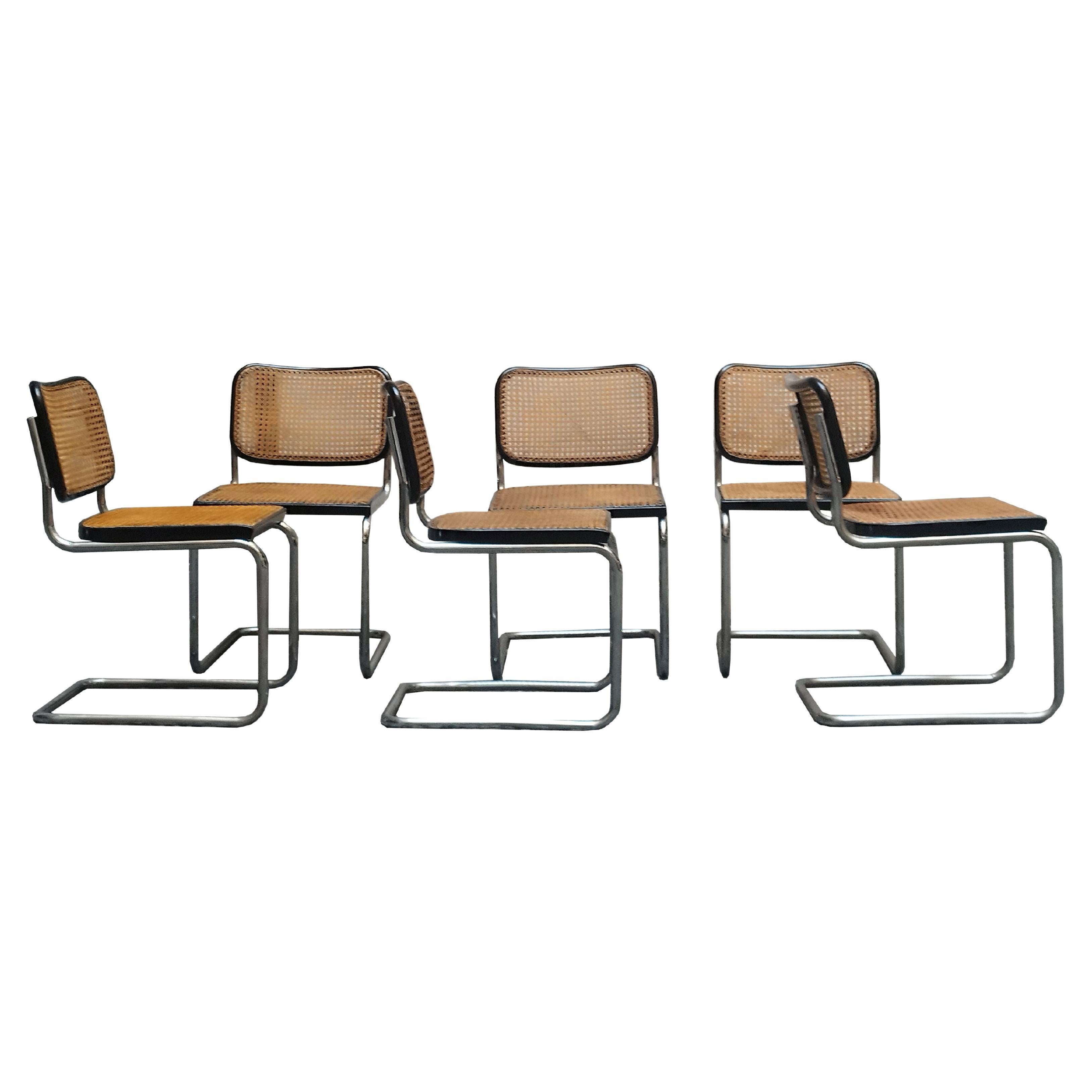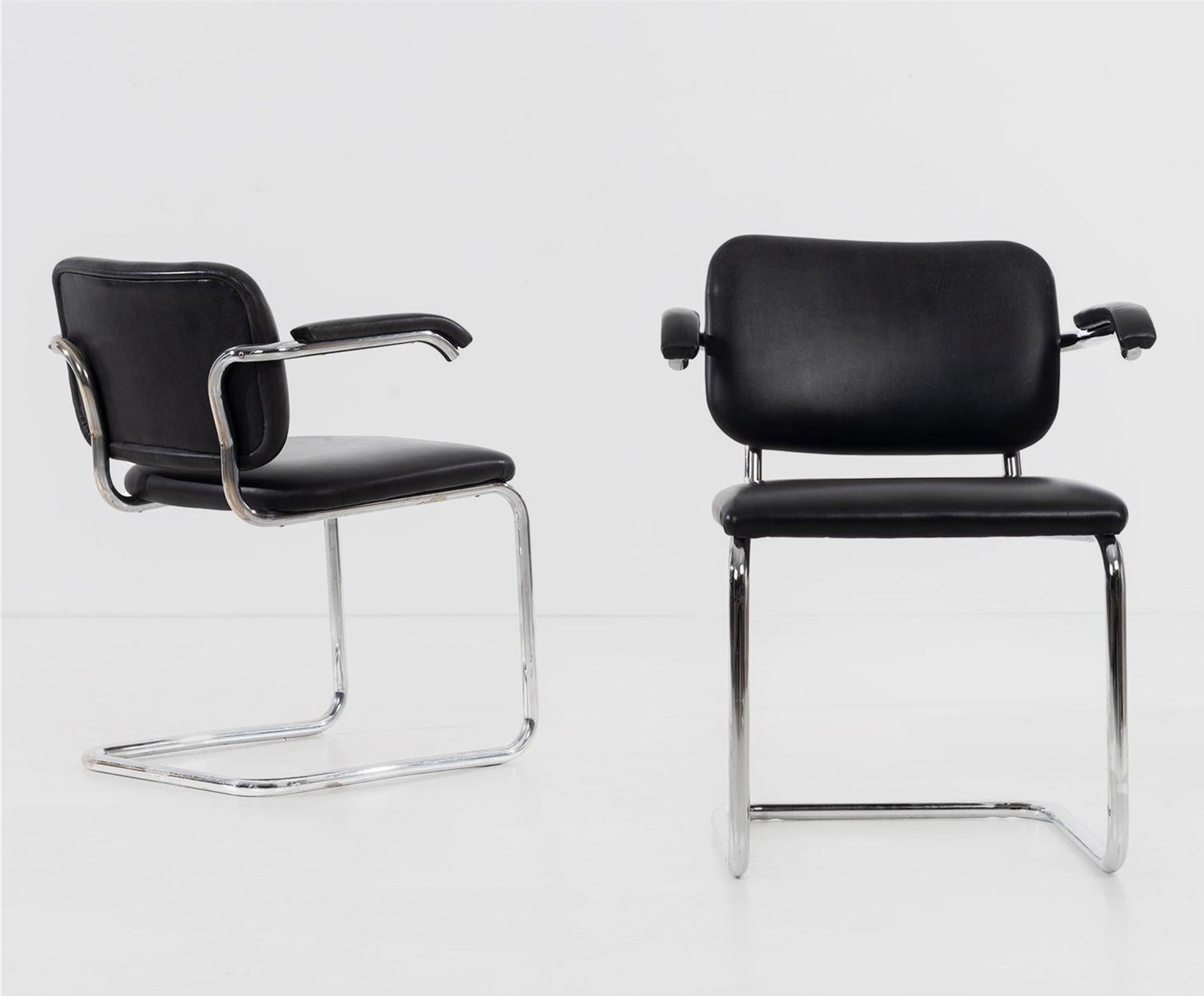Cesca chair by Marcel Breuer for Gavina 1960s
About the Item
- Creator:Gavina (Manufacturer),Marcel Breuer (Designer)
- Design:
- Dimensions:Height: 30.71 in (78 cm)Width: 18.12 in (46 cm)Depth: 16.54 in (42 cm)Seat Height: 18.12 in (46 cm)
- Style:Mid-Century Modern (Of the Period)
- Materials and Techniques:
- Place of Origin:
- Period:
- Date of Manufacture:1960s
- Condition:Wear consistent with age and use.
- Seller Location:Padova, IT
- Reference Number:1stDibs: LU6345231428352
Cesca Chair
Ubiquitous but never boring, the Cesca chair has defined casual elegance in the dining room since 1928. Designed by Marcel Breuer (1902–81) for the Austrian furniture maker Gebrüder Thonet, the original Cesca chair combines natural beechwood caning and modern tubular steel for a sensibility that celebrates both handicraft and industrialization. It’s a paragon of Bauhaus design, embodying the school’s “truth to materials” philosophy and adhering to the movement’s emphasis on mass production. In fact, the Cesca chair was the first-ever tubular steel frame chair with a caned seat to be mass produced — a breakthrough for furniture design.
Breuer got his start in architecture after dropping out of the painting program at the Academy of Fine Arts in Vienna. He began apprenticing with a Viennese architect and went on to join the Bauhaus movement in 1921, when he was just 19 years old, eventually becoming a master carpenter at the German arts school. While there, Breuer designed furniture for Sommerfeld House in Berlin, industrialist Adolf Sommerfeld’s private residence, which was conceived by architects Walter Gropius (the Bauhaus school’s founder) and Adolf Meyer. Not long afterward, Breuer’s experiments with tubular steel would yield his Wassily chair, named for his friend, painter and Bauhaus professor Wassily Kandinsky, as well as the Cesca.
Originally called the B32, Breuer renamed the chair in honor of his daughter, Francesca, when Italian manufacturer Gavina began producing it in the early 1960s. Knoll introduced the chair when it acquired Gavina in 1968 and continues to manufacture it today.
And while the Cesca chair’s silhouette has remained the same throughout the decades, Breuer himself later made minor modifications, including the implementation of a shallower curve to the back and the addition of a second piece of steel for the frame to account for both comfort and durability. With the Cesca’s cantilevered construction, Breuer’s design transcended that of the traditional four-legged dining chair, pushing the boundaries of what “everyday” could mean in furniture.
Marcel Breuer
The architect and designer Marcel Breuer was one the 20th century’s most influential and innovative adherents of modernism. A member of the Bauhaus faculty, Breuer — like such colleagues as the architects Walter Gropius and Ludwig Mies van der Rohe, and the artists and art theoreticians László Moholy-Nagy and Josef Albers — left Europe in the 1930s to champion the new design philosophy and its practice in the United States.
Born in Hungary, Breuer became a Bauhaus student in 1920 and quickly impressed Gropius, the German school’s founder, with his aptitude for furniture design. His early work was influenced by the minimalist Dutch design movement De Stijl — in particular the work of architect Gerrit Rietveld. In 1925, while he was head of the Bauhaus furniture workshop, Breuer realized his signature innovation: the use of lightweight tubular-steel frames for chairs, tables and sofas — a technique soon adopted by Mies and others. Breuer’s attention gradually shifted from design to architecture, and, at the urging of Gropius, he joined his mentor in 1937 on the faculty of Harvard and in an architectural practice.
In the 1940s, Breuer opened his own architectural office, and there his style evolved from geometric, glass-walled structures toward a kind of hybrid architecture — seen in numerous Breuer houses in New England — that pairs bases of local fieldstone with sleek, wood-framed modernist upper floors. In his later, larger commissions, Breuer worked chiefly with reinforced concrete and stone, as seen in his best-known design, the brutalist inverted ziggurat built in New York in 1966 as the home of the Whitney Museum of American Art.
Breuer’s most famous furniture pieces are those made of tubular steel, which include the Wassily chair — named after Wassily Kandinsky and recognizable for its leather-strap seating supports — and the caned Cesca chair. Breuer also made several notable designs in molded plywood, including a chaise and nesting table for the British firm Isokon and a student furniture suite commissioned in 1938 for a dormitory at Bryn Mawr College. Whether in metal or wood, Breuer’s design objects are elegant and adaptable examples of classic modernist design — useful and appropriate in any environment.
Find vintage Marcel Breuer seating, storage cabinets and lighting on 1stDibs.
- ShippingRetrieving quote...Ships From: Albignasego, Italy
- Return PolicyA return for this item may be initiated within 14 days of delivery.
- Set of 4 Original Cesca Chairs, by Marcel Breuer for Gavina, ItalyBy Gavina, Marcel BreuerLocated in Padova, ITOriginal Cesca chair by Marcel Lajos Breuer for Gavina - Italy - with original label. Back lowered walnut wood - crome tubolari steel frame - Vienn...Category
Vintage 1970s Italian Mid-Century Modern Chairs
MaterialsSteel
- Set of 2 Gea Wooden Side Tables by Kazuhide Takahama for Gavina, 1960sBy Gavina, Kazuhide TakahamaLocated in Padova, ITKazuhide Takahama (Nobeoka, 1930 - Bologna, February 10, 2010 [1]) was a Japanese architect and designer. Born in 1930, he studied architecture in Tokyo and after graduation joined ...Category
Vintage 1960s Italian Mid-Century Modern Side Tables
MaterialsWood
- Swivel Side Table Gea Model by Kazuhide Takahama for Gavina 1960s-1970sBy Gavina, Kazuhide TakahamaLocated in Padova, ITSwivel side table Gea model by Kazuhide Takahama for Gavina 1960s-1970s. Cylindrical base on which the bedside table is inserted with a pivot that favors its rotation. Kazuhide Takahama (Nobeoka, 1930 - Bologna, February 10, 2010 [1]) was a Japanese architect and designer. Born in 1930, he studied architecture in Tokyo and after graduation joined the studio of Kazuo Fujioka. In 1957 he came to Italy to supervise the architectural layout of the pavilion with which Japan participated for the first time in the XI Triennale di Milano, where he met the designer and entrepreneur Dino Gavina (1922-2007) with whom he undertook a professional collaboration that it would last a lifetime. Consequently in 1964 he moved to Bologna and went to work as a furniture and lamp designer in the San Lazzaro factory. In 1968 Gavina sold his company Gavina SPA to Knoll International, with the related factory in Foligno designed by Achille Castiglioni, and together with Maria Simoncini (1927-2010) founded the Simon international manufacturer (later acquired by Cassina) and the year later the exhibition and commercial center named after Marcel Duchamp opened in Bologna with the participation of the famous Dadaist painter and photographer Man Ray. In these new locations, Takahama was able to collaborate with the famous architect and designer Carlo Scarpa and in the following years he carried out an intense professional activity which led to the creation of furniture and lamps of various types, which still constitute as many works of art, characterized always with great simplicity and formal cleanliness and very often rigorous like Zen compositions. His colleagues said that he was so silent as to be called "the man of stone" but his presence was clearly perceptible. Takahama continued to carry out his activity as a designer until his death in 2010. Gavina Spa was founded by Dino Gavina in 1960, who assumed the role of managing director and called the architect Carlo Scarpa to the presidency. The historic headquarters of the company are located in San Lazzaro di Savena, in a building designed by Pier Giacomo Castiglioni in 1959. In 1963, thanks to state incentives for the development of southern Italy, Dino Gavina opened an office in Foligno. In 1962 Dino Gavina met Marcel Breuer in New York and convinced him to re-edit and realize his projects from the 1920s. Among the designers who worked for the company: Pier Giacomo Castiglioni, Achille Castiglioni, Carlo Scarpa, Ignazio Gardella, Tobia Shoe. After the sale of the American company Knoll in 1968 and the closure of the Bolognese brand, several products of the Gavina collection were sold under the Knoll brand; some of them were later sold to other manufacturers (such as the Sanluca armchair...Category
Vintage 1960s Italian Mid-Century Modern Side Tables
MaterialsWood
- Set of 2 ocra yellow chairs Rennie mod. by K. Takahama for S. Gavina 70's, ItalyBy Kazuhide Takahama, Simon Gavina EditionsLocated in Padova, ITLacquered wood structure and yellow ocher velvet covering. Very good condition, with small and inevitable signs of age and use on the lacquered parts. azuhide Takahama - Nobeoka 193...Category
Vintage 1970s Italian Mid-Century Modern Chairs
MaterialsVelvet, Wood
- Pair of wicker egg chairs by Bonacina 1960sBy BonacinaLocated in Padova, ITLeader in the production of this type of object, each piece by Bonacina is handcrafted by skilled craftsmen who, with care and experience, bend the reeds, weave and intertwine the ma...Category
Vintage 1960s Italian Mid-Century Modern Chairs
MaterialsWicker
- Vanessa metal bed by Tobia Scarpa for Gavina 70sBy Gavina, Tobia ScarpaLocated in Padova, ITBorn in Venice in 1935, Tobia Scarpa is the son of the famous architect Carlo Scarpa. Together with his wife Afra, Tobia began working in the Venini glass factory in Murano in the 19...Category
Vintage 1970s Italian Mid-Century Modern Beds and Bed Frames
MaterialsMetal
- Marcel Breuer, set of Four Cesca Chairs for Gavina. Italy 1960sBy Gavina, Marcel BreuerLocated in Catania, CTFour Cesca chairs designed by Marcel Breuer and produced in Italy by Gavina during the 60s. Very good vintage condition with normal trace of age and use. Slight oxidation on the chro...Category
Mid-20th Century Italian Mid-Century Modern Chairs
MaterialsChrome
- MidCentury Cesca Armchair in Chrome and Straw by Marcel Breuer for Gavina, 1960sBy Gavina, Marcel BreuerLocated in Roma, ITGorgeous mid-century Cesca armchair in chromed metal and woven wicker chairs. These beautiful chair was designed by Marcel Breuer and produced by Gavina in Italy during the 1960s. T...Category
Mid-20th Century Italian Mid-Century Modern Chairs
MaterialsMetal, Chrome
- Chair by Marcel Breuer for Gavina, circa 1960By Gavina, Marcel BreuerLocated in Barcelona, BarcelonaChair designed by Marcel Breuer, manufactured by Gavina, Italy. In original condition, with minor wear consistent with age and use, preserving a beautiful patina. Seat has a smal...Category
Vintage 1960s Spanish Mid-Century Modern Chairs
MaterialsSteel
- Set of 2 Chairs Cesca, Marcel Breuer, Gavina, 1970By Marcel Breuer, GavinaLocated in Milano, LombardiaSet of 2 Chairs Cesca, Marcel Breuer, Gavina, 1970. The Set of 2 Cesca Chairs, designed by Marcel Breuer in 1970 for Gavina, epitomizes modernist elegan...Category
Vintage 1970s Italian Mid-Century Modern Chairs
MaterialsMetal
- Marcel Breuer for Gavina Set of 6 "Cesca" Chairs, Italy 1960sBy Marcel Breuer, GavinaLocated in Naples, ITSet of 6 Cesca chairs designed by Marcel Breuer, produced by Gavina in 1960. The chairs show slight signs of wear, the seats are original Vienna straw. The combination of Vienna stra...Category
Vintage 1960s Italian Mid-Century Modern Dining Room Chairs
MaterialsMetal
- Marcel Breuer for Gavina Set of Four Cesca Chairs, Italy 1970sBy Marcel Breuer, GavinaLocated in Naples, ITGroup of four chairs Mod. Cesca by Marcel Lajos Breuer for Gavina - Italy - with original label. Walnut backrest, chromed steel tubular frame and Vienna straw. Breuer's Cesca chair h...Category
Vintage 1970s Italian Mid-Century Modern Chairs
MaterialsChrome
